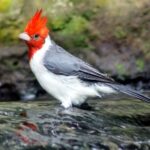Owning a pet bird brings both joy and responsibility. One key aspect of their care involves providing them with the right number of toys. Birds should have at least 8-12 toys in their cage to ensure they stay mentally and physically stimulated. This keeps them engaged and prevents boredom.
Different species and individual preferences can affect the type and number of toys needed. Birds with more out-of-cage time or stronger behavioral traits might require more toys. Carefully choose toys that cater to your bird’s specific tastes and activity level.
Safety is also a significant factor when selecting bird toys. Ensure the materials are non-toxic and appropriate for your bird’s size and strength to prevent injuries. Rotating toys regularly can keep your bird interested and provide continuous enrichment.
Image Credit: https://www.flickr.com/photos/92442038@N00/424718377
Creating a Stimulating Environment for Your Feathered Friend
General Guidelines
There’s no magic number when it comes to bird toys. However, a good rule of thumb is to provide a variety that caters to different needs and preferences. Aim for a minimum of 5-7 toys per bird in their cage, but feel free to add more if space allows.
Types of Toys
Variety is key to keeping your bird engaged and mentally stimulated. Offer a mix of the following types:
- Chewing toys: Satisfy your bird’s natural instinct to gnaw and help keep their beak trim.
- Foraging toys: Encourage natural behaviors like searching for food and problem-solving.
- Puzzle toys: Challenge your bird’s intelligence and provide mental stimulation.
- Interactive toys: Encourage social interaction and bonding with you or other birds.
- Foot toys: Promote foot exercise and coordination.
Rotating Toys
Birds can get bored with the same toys over time. Rotate them regularly to keep things interesting. Introduce new toys every few weeks, and put away older ones for a while. This helps prevent boredom and encourages exploration.
Size and Safety
Choose toys appropriate for your bird’s size and species. Avoid toys with small parts that could be ingested or pose a choking hazard. Check for loose threads, sharp edges, or any other potential dangers.
Observation and Adjustment
Pay attention to your bird’s preferences. Some birds might favor certain types of toys or materials. Adjust your selection based on what they seem to enjoy the most.
Toy Rotation Schedule
| Week | Toy 1 | Toy 2 | Toy 3 | Toy 4 | Toy 5 |
|---|---|---|---|---|---|
| 1 | Chew Toy A | Foraging Toy A | Puzzle Toy A | Interactive Toy A | Foot Toy A |
| 2 | Chew Toy B | Foraging Toy B | Puzzle Toy B | Interactive Toy B | Foot Toy B |
| 3 | Chew Toy A | Foraging Toy B | Puzzle Toy A | Interactive Toy B | Foot Toy A |
| 4 | Chew Toy B | Foraging Toy A | Puzzle Toy B | Interactive Toy A | Foot Toy B |
This is just a sample schedule. You can adjust the frequency and types of toys based on your bird’s needs and preferences.
Key Takeaways
- Birds need at least 8-12 toys for mental stimulation.
- Adjust the number of toys based on species and preferences.
- Ensure all toys are safe and non-toxic.
Understanding Bird Toy Essentials
When selecting toys for birds, owners must consider the bird’s mental and physical needs. This section breaks down the importance of toys, the different types available, and the necessity of variety and rotation in maintaining a bird’s well-being.
Importance of Toys for Bird Well-Being
Toys play a critical role in a bird’s life. They provide mental stimulation, preventing boredom and reducing stress-related behaviors. Toys also encourage physical activities, which contribute to a bird’s health. Birds use toys to engage in natural behaviors like foraging and chewing, ensuring they remain active and entertained.
Interactive toys, such as puzzles, can challenge a bird’s intellect. These toys can improve problem-solving skills and keep the bird’s mind sharp. Without enough physical and mental stimulation, birds can develop negative behaviors, such as feather plucking or excessive screaming.
Types of Toys for Different Bird Activities
Birds need a variety of toys to keep them engaged. Foraging toys allow birds to hunt for their food, mimicking their natural behavior in the wild. They often involve hidden treats that birds must uncover, promoting mental engagement.
Chew toys are perfect for parrots and other birds that enjoy gnawing. These toys help maintain beak health by providing a safe outlet for their natural chewing instinct. They come in various materials, including wood and safe plastics.
Interactive toys like mirrors or bells can keep birds entertained. These toys respond to a bird’s actions, providing immediate feedback and encouraging repeated play.
Toy Variety and Rotation
Keeping toys fresh and exciting is vital for a bird’s happiness. Rotating toys regularly prevents birds from becoming bored with their environment. A good practice is to have a set number of toys in the cage while keeping extras on hand to swap out frequently.
When introducing new toys, observe the bird’s reaction to ensure safety and interest. Different birds have different preferences, so offering a mix of toys can cater to a bird’s specific tastes and needs.
Toy variety and rotation also enhance physical exercise, mental stimulation, and overall enrichment. By keeping the bird’s playtime engaging, owners can help maintain the bird’s physical health and emotional well-being.
Frequently Asked Questions
Bird toys are important for a bird’s mental and physical health. These questions cover toy quantities, rotation schedules, types of toys needed, and how they affect bird behavior.
What is the recommended number of toys for a bird’s cage?
The recommended number of toys varies by bird size. Small birds like Budgies need 3-5 toys. Medium birds like Cockatiels need about 8-12 toys. Larger birds may require more toys to stay engaged.
How frequently should bird toys be rotated to maintain the bird’s interest?
Bird toys should be rotated every 2-3 weeks. This keeps the bird curious and engaged. It also helps to prevent boredom and encourages playing with different types of toys.
What are the necessary types of toys for a bird’s mental stimulation?
Birds need a variety of toys for mental stimulation. Foraging toys, chew toys, and puzzle toys are essential. These types of toys can help mimic natural behaviors like hunting for food or chewing on branches.
How can the number of toys affect a bird’s behavior and well-being?
Providing the right number of toys can prevent boredom and stress. Too few toys can lead to negative behaviors like feather plucking. On the other hand, having enough toys encourages exercise and exploration.
Is there a risk of overstimulation from too many toys for birds?
Yes, there is a risk of overstimulation. Too many toys in a cage can make it hard for the bird to move around. It can also overwhelm the bird, leading to stress or anxiety.
What factors should be considered when selecting toys for different species of birds?
Consider the bird’s size, beak strength, and natural behaviors. Smaller birds need smaller, lighter toys. Birds that like to chew need durable toys. Each species has unique needs that should be addressed for their well-being.






